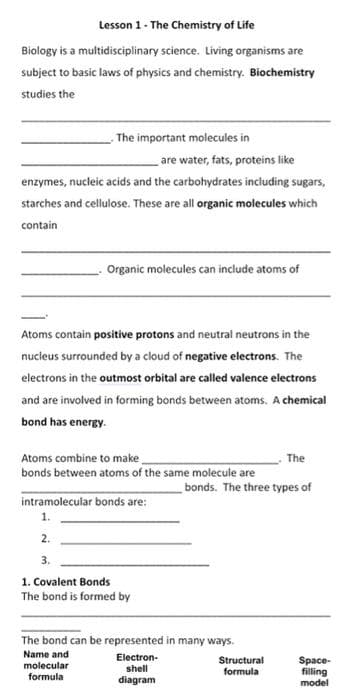Lesson 1- The Chemistry of Life Biology is a multidisciplinary science. Living organisms are subject to basic laws of physics and chemistry. Biochemistry studies the The important molecules in are water, fats, proteins like enzymes, nucleic acids and the carbohydrates including sugars, starches and cellulose. These are all organic molecules which contain Organic molecules can include atoms of Atoms contain positive protons and neutral neutrons in the nucleus surrounded by a cloud of negative electrons. The electrons in the outmost orbital are called valence electrons and are involved in forming bonds between atoms. A chemical bond has energy. Atoms combine to make bonds between atoms of the same molecule are The bonds. The three types of intramolecular bonds are: 1. 2. 3. 1. Covalent Bonds The bond is formed by The bond can be represented in many ways. Name and Electron- Structural formula Space- filling model molecular shell formula diagram
Lesson 1- The Chemistry of Life Biology is a multidisciplinary science. Living organisms are subject to basic laws of physics and chemistry. Biochemistry studies the The important molecules in are water, fats, proteins like enzymes, nucleic acids and the carbohydrates including sugars, starches and cellulose. These are all organic molecules which contain Organic molecules can include atoms of Atoms contain positive protons and neutral neutrons in the nucleus surrounded by a cloud of negative electrons. The electrons in the outmost orbital are called valence electrons and are involved in forming bonds between atoms. A chemical bond has energy. Atoms combine to make bonds between atoms of the same molecule are The bonds. The three types of intramolecular bonds are: 1. 2. 3. 1. Covalent Bonds The bond is formed by The bond can be represented in many ways. Name and Electron- Structural formula Space- filling model molecular shell formula diagram
Introduction to General, Organic and Biochemistry
11th Edition
ISBN:9781285869759
Author:Frederick A. Bettelheim, William H. Brown, Mary K. Campbell, Shawn O. Farrell, Omar Torres
Publisher:Frederick A. Bettelheim, William H. Brown, Mary K. Campbell, Shawn O. Farrell, Omar Torres
Chapter2: Atoms
Section: Chapter Questions
Problem 2.89P: 2-89 Assume that a new element has been discovered with atomic number 117. Its chemical properties...
Related questions
Question
100%

Transcribed Image Text:Lesson 1- The Chemistry of Life
Biology is a multidisciplinary science. Living organisms are
subject to basic laws of physics and chemistry. Biochemistry
studies the
The important molecules in
are water, fats, proteins like
enzymes, nucleic acids and the carbohydrates including sugars,
starches and cellulose. These are all organic molecules which
contain
Organic molecules can include atoms of
Atoms contain positive protons and neutral neutrons in the
nucleus surrounded by a cloud of negative electrons. The
electrons in the outmost orbital are called valence electrons
and are involved in forming bonds between atoms. A chemical
bond has energy.
Atoms combine to make.
bonds between atoms of the same molecule are
The
bonds. The three types of
intramolecular bonds are:
1.
2.
3.
1. Covalent Bonds
The bond is formed by
The bond can be represented in many ways.
Name and
Electron-
Structural
Space-
filling
model
molecular
shell
formula
formula
diagram
Expert Solution
This question has been solved!
Explore an expertly crafted, step-by-step solution for a thorough understanding of key concepts.
Step by step
Solved in 2 steps

Knowledge Booster
Learn more about
Need a deep-dive on the concept behind this application? Look no further. Learn more about this topic, chemistry and related others by exploring similar questions and additional content below.Recommended textbooks for you

Introduction to General, Organic and Biochemistry
Chemistry
ISBN:
9781285869759
Author:
Frederick A. Bettelheim, William H. Brown, Mary K. Campbell, Shawn O. Farrell, Omar Torres
Publisher:
Cengage Learning

Chemistry for Engineering Students
Chemistry
ISBN:
9781337398909
Author:
Lawrence S. Brown, Tom Holme
Publisher:
Cengage Learning

Introduction to General, Organic and Biochemistry
Chemistry
ISBN:
9781285869759
Author:
Frederick A. Bettelheim, William H. Brown, Mary K. Campbell, Shawn O. Farrell, Omar Torres
Publisher:
Cengage Learning

Chemistry for Engineering Students
Chemistry
ISBN:
9781337398909
Author:
Lawrence S. Brown, Tom Holme
Publisher:
Cengage Learning